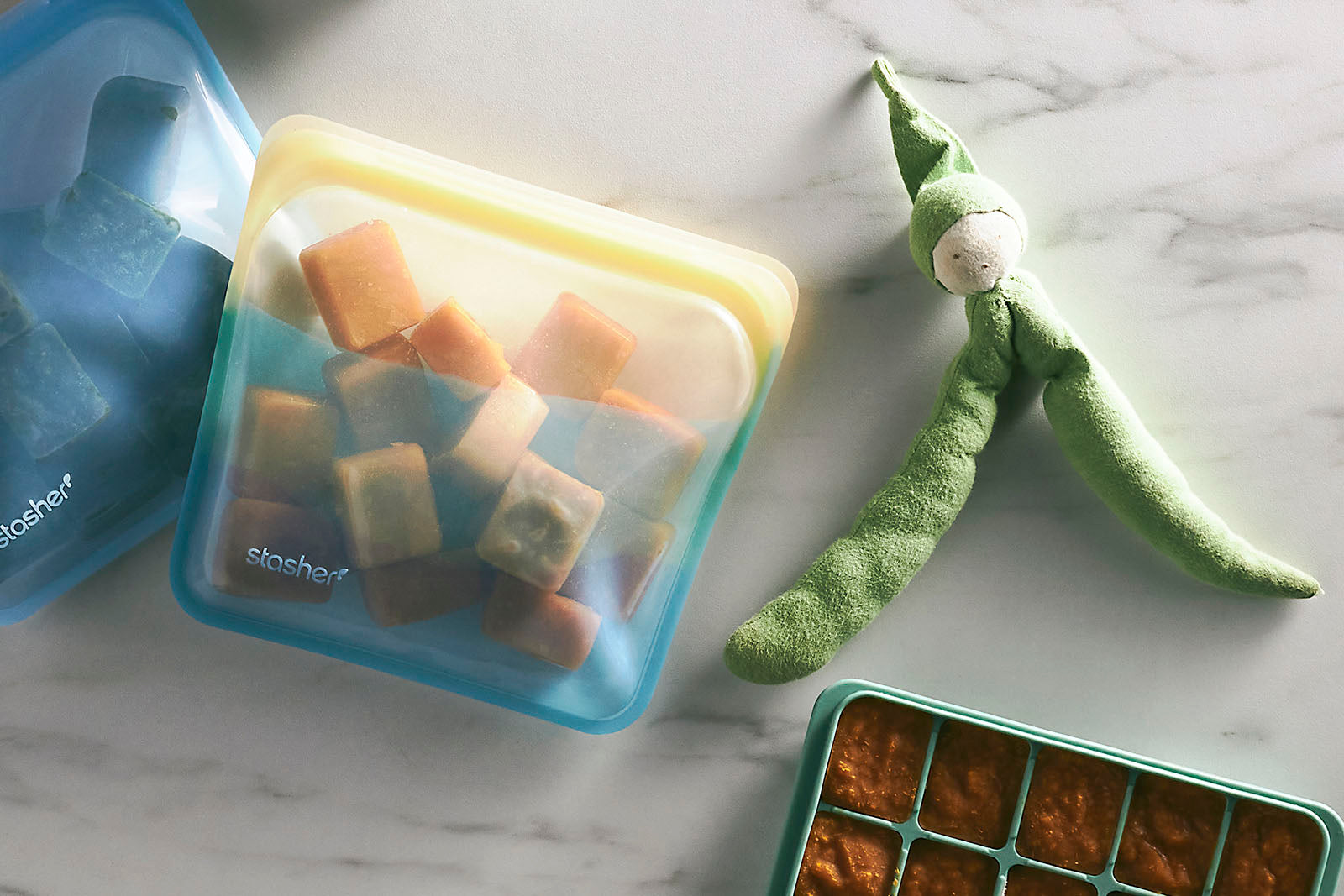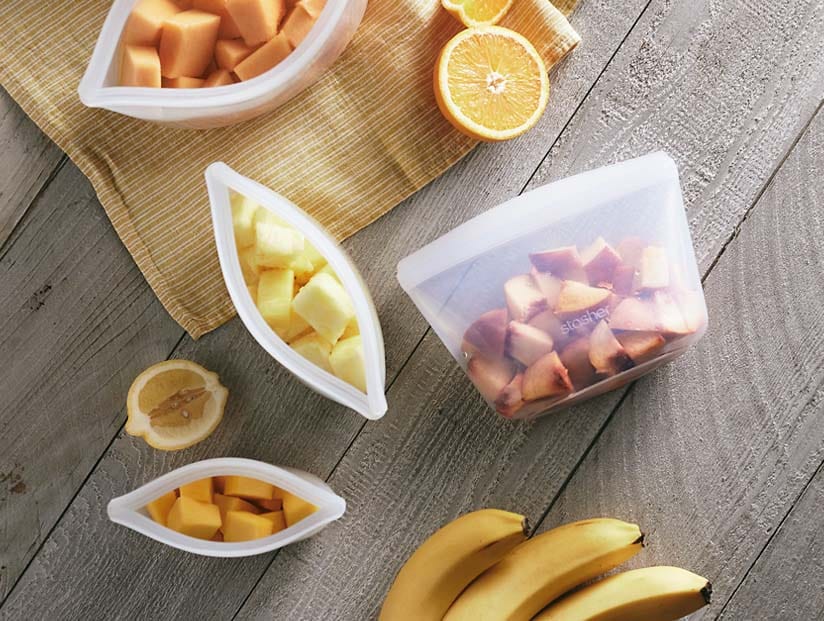
How To Make Butternut Squash Baby Food
If you’re ready to introduce solid foods to your baby’s diet, you may want to consider making homemade baby food. There are tons of healthy and nutritious baby food recipes out there (like this one for butternut squash baby food!) that are great for your little one and a total time-saver for you. With homemade baby food, you can make a large batch and freeze it in individual portions in 1 Cup Stasher Bowls or in an ice cube tray (no single-use plastics here!). Then, in the future, all you have to do is defrost and serve – easy peasy. One of the most popular first foods for babies is butternut squash, so we’re walking you through the process of making quick, easy butternut squash baby food the sustainable way!
How to Make Butternut Squash Puree
Butternut squash puree is one of the easiest homemade baby foods because there are tons of different ways to make it.
Step 1: First, carefully slice your butternut squash in half. Use a fork to scrape out as much of the pulp and seeds as you can, but don’t worry about doing it perfectly – we’ll get the rest after cooking.
Step 2: To microwave your squash, place the cut side down on a large Stasher bag laid flat or a microwave-safe container. Cook on high for 5 minutes or until the squash is softened all the way through.
If you’re roasting your butternut squash, preheat the oven to 375F and roast cut side up on a rimmed baking pan for about 45 minutes. The key is to ensure that the butternut squash is cooked thoroughly to destroy any bacteria that might make your little one sick.
Step 3: Whether you oven-baked or microwaved your squash, the next step is the same: let the squash cool until it can be handled, and then scoop out the flesh with a large spoon. (If you didn’t remove all the pulp and seeds prior to cooking, now’s the time to do so.)
Step 4: Spoon the butternut squash flesh into a food processor and pulse till smooth. If the consistency is too thick, you can add a little bit of liquid like breastmilk or formula to thin it out.
And there you have it: butternut squash baby food! Puree baby foods are a simple, nutritious way to start introducing your baby to solids and expanding their diet alongside their normal breastmilk or formula.
Butternut Squash Baby Food Ideas
On its own, butternut squash is a super nutritious choice for your baby because it’s packed with vitamin A, potassium, and fiber to support healthy development and digestion. But you can also fold more nutrition into butternut squash puree – and introduce your little one to new flavors – by mixing in other purees, spices, or herbs. (Most pediatricians suggest sticking to single-ingredient foods until your little one is about 6 to 8 months old.)
You can easily make both sweet purees and savory purees from your butternut squash mixture based on the spices you add. For sweet baby food, add a pinch of an aromatic spice like nutmeg, turmeric, cinnamon, or clove. For savory baby food, try a gentle dusting of cumin, mild curry, smoked paprika, or garlic, or pureed herbs like thyme or basil.
Mixing two different purees is also an easy way to meet your baby’s individual nutritional needs. Try adding one of the following homemade purees to butternut squash for an extra tasty, ultra-nutritious meal for your baby:
- Carrot puree
- Chicken puree
- Sweet potato puree
- Applesauce<>

How to Store Butternut Squash Puree
Fresh homemade baby food lasts in a Stasher bowl in the fridge for up to three days. When you’re ready to serve, just pull out the individually portioned 1-Cup Stasher Bowl from the fridge and either float the bowl in a pot of hot water or pop it in the microwave for about 15 seconds. Remember: cooking baby food all the way through is super important to nix bacteria, so make sure that puree is piping hot! Then set it aside for a few minutes, stir, and test it yourself to make sure it’s cooled sufficiently for your baby.
Meanwhile, homemade baby food keeps in the freezer for up to three months. Here’s our favorite way to freeze baby food: after you’ve whipped up a homemade puree in bulk, pour it into ice cube trays and freeze. Once the cubes have frozen completely, pop them out and plop them into freezer-friendly storage containers like the Stasher Sand-Up Mega Bag or the Stasher 8 Cup Bowl. Now you’ve got individual portions of baby food that are ready to reheat in seconds! (And we don’t mean to sound like a broken record, but remember to heat that baby food safely and thoroughly, especially if you store baby food in the freezer!)
Can You Refreeze Butternut Squash Puree?
Wondering what to do with baby food leftovers that have already been frozen and reheated? Toss them! While we’re big fans of reducing waste, it can be dangerous to your baby’s health to refreeze and re-thaw baby food, as doing so allows harmful bacteria to grow. So in the interest of food safety and for the sake of your little one, discard leftovers if they’ve been thawed previously and have been in the fridge for two days.
But here’s the good news: it is possible to minimize food waste by thinking ahead a little bit during prep and freezing baby food in single-sized portions using the ice cube tray method or 1-Cup Stasher Bowls. By freezing super small, individual portions in food containers, you’re minimizing the amount of food that’s being thawed at any given time, and thereby minimizing the amount of leftovers that will need tossing.
The moral of the story? Storing butternut squash puree or other baby food in single-serving containers is a major time saver, and it cuts down on potential food waste. And by opting for your trusty Stasher bags or bowls, you’re keeping countless single-use plastic bags out of landfills and oceans – and helping to create a better world for your baby to enjoy.









